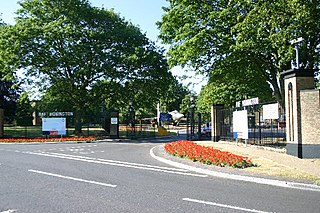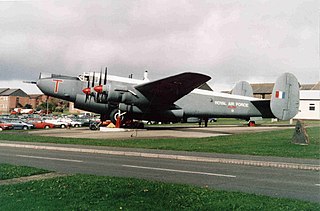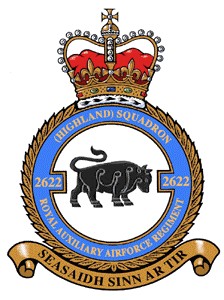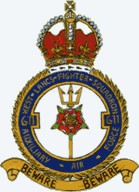
The Royal Air Force Regiment is part of the Royal Air Force and functions as a specialist corps. Founded by Royal Warrant in 1942, the Corps carries out soldiering tasks relating to the delivery of air power. Examples of such tasks are Non Combatant Evacuation Operations (NEO), recovery of downed aircrew, and in-depth defence of airfields by way of aggressively patrolling a large area of operations outside airfields in hostile environments. In addition the RAF Regiment provides Joint Terminal Attack Controllers (JTACs) to the British Army and Royal Marines, and provides flight size commitment to the Special Forces Support Group.

Royal Air Force Honington or more simply RAF Honington is a Royal Air Force station located 6 mi (9.7 km) south of Thetford near Ixworth in Suffolk, England. Although used as a bomber station during the Second World War, RAF Honington is now the RAF Regiment depot.

Royal Air Force St Mawgan or more simply RAF St Mawgan is a Royal Air Force station near St Mawgan and Newquay in Cornwall, England. In 2008 the runway part of the site was handed over to Newquay Airport. The remainder of the station continues to operate under the command of the RAF. RAF St Mawgan used to have the widest military runway in the UK (300 ft) and was the home of the Cornwall Air Ambulance service and more recently 505 (Wessex) Squadron Royal Auxiliary Air Force (RAuxAF).

The Royal Air Force Police (RAFP) is the service police branch of the Royal Air Force, headed by the provost marshal of the Royal Air Force. Its headquarters are at RAF Honington and it deploys throughout the world to support RAF and UK defence missions.
The Tactical Police Squadron (TPS) is a group of around 150 regular and 50 reservist (RAuxAF) Royal Air Force Police with its headquarters at RAF Honington in Suffolk, England. The reservists comprise No 3 Police Squadron.

The Royal Auxiliary Air Force (RAuxAF), formerly the Auxiliary Air Force (AAF), together with the Air Force Reserve, is a component of Her Majesty's Reserve Air Forces. It provides a primary reinforcement capability for the regular service, and consists of paid volunteers who give up some of their weekends, evenings and holidays to train at one of a number of squadrons around the United Kingdom. Its current mission is to provide trained personnel in support of the regular RAF. Queen Elizabeth II is Air Commodore-in-Chief of the RAuxAF.

No. 607 Squadron is an auxiliary squadron of the Royal Air Force. It was formed in 1930 as a bomber unit in the Auxiliary Air Force and changed in 1936 to the fighter role. It fought in that role during the Second World War in Europe and Asia. After the war, in 1946, the squadron reformed as a fighter unit. Awarded the title Royal Auxiliary Air Force by King George in 1947, 607 Sqn was disbanded with all the other flying units of the RAuxAF on 10 March 1957. It reformed on 5 January 2015, as a General Service Support Squadron (GSS).
The Royal Air Force Volunteer Reserve (RAFVR) was established in 1936 to support the preparedness of the U.K. Royal Air Force in the event of another war. The Air Ministry intended it to form a supplement to the Royal Auxiliary Air Force (RAuxAF), the active reserve for the RAF, by providing an additional non-active reserve. However during the Second World War the high demand for aircrew absorbed all available RAuxAF personnel and led the RAFVR to quickly become the main pathway of aircrew entry into the RAF. It was initially composed of civilians recruited from neighbourhood reserve flying schools, run by civilian contractors with largely RAF-trained flying instructors as well as other instructors in related air war functions, such as observers and wireless operators.
No. 4626 Aeromedical Evacuation Squadron is a unit of the British Royal Auxiliary Air Force, which manages, maintains and trains its personnel for operational readiness in support of RAF requirements for Aeromedical Evacuation and Pre-Hospital Emergency Care, Primary Healthcare (PHC) and individual augmentees to other military healthcare capabilities, in times of conflict or crisis.

No. 2622 (Highland) Squadron RAuxAF Regiment, is a Royal Auxiliary Air Force RAF Regiment reserve squadron based at RAF Lossiemouth. It is the northernmost RAuxAF Unit in the United Kingdom and was formed in 1979 to assist with the ground defence of that airfield. Initially, personnel were recruited solely from the local area but recruiting now extends as far south as Edinburgh and Glasgow and to the North, East and West Coasts of Scotland. The Squadron is established for 116 Auxiliary personnel plus a small contingent of regular RAF personnel.

No. 611 Squadron is a British Royal Air Force squadron. It was first formed in 1936 and was disbanded in 1957 after seeing combat as a fighter unit during the Second World War. It was reformed as a reserve squadron in 2013.
No. 7010 (VR) Photographic Interpretation Squadron, Royal Auxiliary Air Force is a unit of the British Royal Air Force. It was founded in April 1953 as No. 7010 Flight, Royal Air Force Volunteer Reserve, to provide strategic imagery analysis support to the Royal Air Force. In 1965 the flight expanded its role to include tactical imagery analysis. In August 1982, Her Majesty The Queen approved the issue of a badge to the flight. In allusion to the unit's role, the emblem of a human eye is portrayed with a wing embellishment and set in front of a roundel. The motto Vocati Veniemus may be freely translated as "when summoned we shall be there". The collapse of the Warsaw Pact resulted in a large reduction of NATO forces in central Europe. In turn this has led to a major reduction in, and reorganisation of, the United Kingdom's regular and reserve forces. Within this overall plan for defence, No. 7010 Flight became No. 7010 (VR) Photographic Interpretation Squadron.

No. 600 Squadron RAuxAF is a squadron of the RAF Reserves. It was formed in 1925 and operated as a night fighter squadron during the Second World War with great distinction. After the war, 600 Squadron went on to operate jet fighters until 1957. Reactivated in 1999, 600 Squadron is the only RAF Reserve unit within the M25. It is a Headquarters Support Squadron and provides trained part-time reservists to support RAF operations around the world.
No. 2623 Squadron RAuxAF Regiment is a Royal Auxiliary Air Force RAF Regiment reserve squadron based at RAF Honington. It was formed on 1 July 1979 to provide ground defence of the station. Tasked with preventing Soviet Special Forces from disrupting flying operations, personnel were recruited from across East Anglia and formed an integral part of the station's war-fighting capability for the next 15 years. Throughout this period, the squadron participated in many exercises and held annual camps in the United Kingdom, Germany and Gibraltar, winning the Strickland Trophy competition in 1991.
The RAF Force Protection Force Headquarters was created in 2004 as the successor to the Tactical Survive to Operate Headquarters. It controls the Force Protection Wings which are tasked with protection of RAF stations in the UK and overseas. Each Wing is based around a mix of RAF Regiment and RAF Police squadrons and other support staff.
No. 2620 Squadron RAuxAF Regiment is a Royal Auxiliary Air Force RAF Regiment reserve squadron based at RAF Marham, in Norfolk, fairly close to the RAF Regiment's main base at RAF Honington, in northern Suffolk, and not far from 2623 Squadron, another RAF Regiment auxiliary squadron, based in Honington.
No. 2503 Squadron RAuxAF Regiment is a Royal Auxiliary Air Force RAF Regiment reserve squadron based at RAF Waddington, in Lincolnshire, fairly close to the city of Lincoln and RAF Cranwell. Gunners are recruited both from ex-regulars in the RAF Regiment and civilians in a 50 miles radius surrounding RAF Waddington. The squadron is an infantry squadron in the dismounted close-combat force protection role.
At the end of the Cold War in 1989 the Royal Air Force structure was as follows:
This is the structure of the Royal Air Force, as of October 2020.
No. 505 (Wessex) Squadron, Royal Auxiliary Air Force (RAuxAF) is a general support unit of the Royal Air Force's reserve component, the Royal Auxiliary Air Force.








